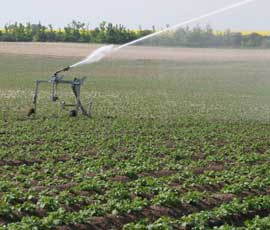Wide-bed potato production offers potential

Planting potatoes in wide-bed systems rather than conventional ridged-rows could increase yields while using less water, an American study has found, which could potentially have implications for UK growers.
Most potato crops in Idaho where the study, partly funded by the US Department of Agriculture, was carried out, are planted using conventional ridged-rows and fed by sprinkler irrigators.
But sprinkler irrigation can work against efficient water management in ridged crops, says agricultural engineer Bradley King, who led the project for the USDA’s Agricultural Research Centre’s Northwest Irrigation and Soils Research Laboratory.
“The problem is runoff from the sides of a ridged potato row allows water to pond in the furrow. That wastes some of the irrigation water because the excess water in the furrows percolates below the crop root zone and becomes unavailable to the plants. Under these conditions, nitrate leaching from the soil can increase.”
Previous research had suggested that planting potatoes in a bed system could increase water use efficiency, and led to the development of two wide-bed planting systems in Idaho by Western Ag Research. Both are 3.7m wide with either five rows spaced 66cm apart centred on the bed, or seven rows equally spaced 46cm apart.
The bed width was selected to be compatible with existing four-row harvesting equipment, although new potato planters have had to be designed. Currently around 4,000ha of wide beds are planted in Idaho, and the study compared the five-row bed system with conventional ridging.
On average, across the 31 field-scale comparisons, yields improved by 6%, used 5% less water, resulting in an 11% increase in irrigation use efficiency, Dr King says.
Use of the five-bed system did not always result in a positive response, he admits. “But there were a greater number of positive outcomes. The bed system has been subject of limited research so has had little opportunity for optimisation. Despite this growers have been able to increase yields and reduce irrigation water use.”
UK perspective
The system could be of interest to UK potato growers, who are increasingly under pressure to grow more, using less. For example, PepsiCo has set its growers a target of reducing water use by 50% in five years.
Some research on wide bed production was carried out in the UK in the 1970s and 1980s by Silsoe, says Melvyn Kay from the UK Irrigation Association. “If I recall correctly, it did have benefits for yield and water use as it avoided runoff from traditional ridge and furrow cultivations, but I believe the main problem was lifting the potatoes during harvest.”
Switching to the system does bring complications, agrees David Firman, head of potato agronomy at Cambridge University Farm. “You have to adapt your machinery for it to work, and integrate it into your system. I think there were some issues of it moving more soil than you would normally too.
“But it is conceivable that this research will generate some interest in the system again.”

